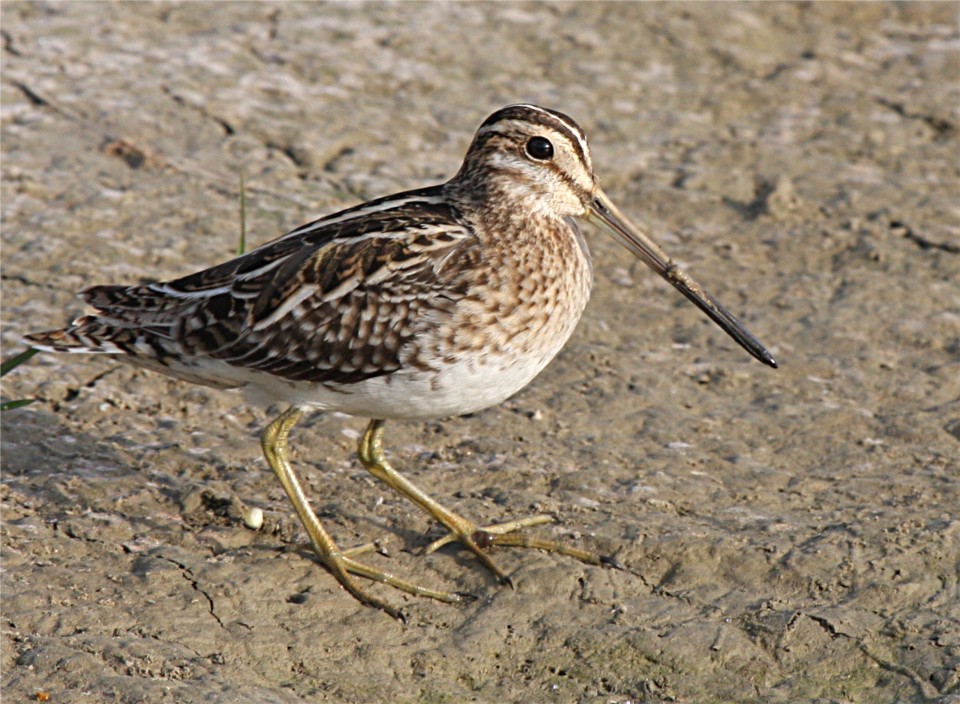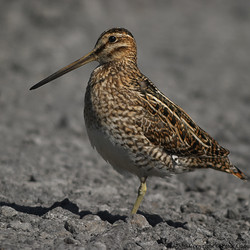Gallinago
Drawing head and beaks of four widespread in Asia Bekassinenarten
The snipe, or snipe ( Gallinago ) are a genus of the family of the Waders ( Scolopacidae ). Most species are very similar, with a very long, slender beak and brown patterned plumage, which provides a good camouflage. They live mostly well hidden in relatively densely vegetated habitats and fall to the breeding season, especially at dawn and dusk by their Balzflüge on, which means the outer tail feathers peculiar sounds are generated. They feed primarily on invertebrates and grope and grab their prey by means of punting Direction movements in the soil or in fine mud.
Fossil skeleton or bones of some undescribed species of the genus Gallinago that are very similar to the snipe were (about 5 mya ) from the Late Miocene or Early Pliocene excavated in deposits in Lee Creek Mine / USA.
Description
The representatives of the genus Gallinago are medium-sized Waders with a 50 mm long Sondierschnabel which is flattened at the top a little and provided with numerous autumn 's corpuscles. The eyes do not sit relatively high on the skull, but as high as the woodcock. The ear opening is located very far forward on the skull, just below the eye. Due to the peculiar construction of the skull brain everted rearward and downward, so that the base is oriented upwards.
The legs are relatively short compared to other Schnepf birds, but longer than that of the woodcock. The tibiotarsus is quite short and unbefiedert in the lower part of the tarsometatarsus to the rear with horny plates covered. The hind toe with claw is well developed. Clamping webs between the toes missing. The wings are relatively slender and slim. The tail is rounded and the number of feathers in contrast to other Limikolenarten increased to 14-18. The outer ones are quite narrow and stiffen. They are of sound production during courtship and can be rotated by strong muscles laterally into the wind. An exception is the great snipe (G. media) that has no Flugbalz. The largest number of feathers has with the 26-28 Spießbekassine (G. stenura ). The outer ones are pin-shaped narrow in this species.
The plumage of the snipe is oberseits predominantly dark brownish patterned with this contrasting light, usually yellowish beige vertical stripes on the head and back, which resolve the shape of the bird perfectly in confused, interspersed with dry stalks of grass stands ( Somatolyse ). Differentiation of plumage characters is very low within the genus. With the exception of four South American species whose appearance and way of life sometimes is more like the woodcock, and will therefore be described by some authors as " aberrant ", all species are very similar, and some indistinguishable in the field from each other. The most important distinguishing feature is the expression of the tail-feathers, which differ significantly even in very similar ways. Other distinctive features are the under wing-coverts, and the facial markings and the extent of banding on the flanks and belly.
The harness of the wings is another way to differentiate
By means of powerful muscles the outer feathers are splayed
They have a special design and are used to the sound generation of the Flugbalz
Dissemination
The breeding distribution of the snipe extends with the exception of Australia and Antarctica across all continents. The greatest species richness exhibit, each with seven species on the Palearctic and the Neotropics. One type colonized the Nearctic and the two Afrotropical region. For species of the temperate zone and the Himalayas are mostly migratory species, wintering in the subtropical and tropical zone. The wintering areas of Waldbekassine and Japanbekassine case extend also over parts of Australia.
System
In the 18th century, known at the time Bekassinenarten were put together with today's woodcock in the genus erected by Linnaeus Scolopax. 1816 a separate genus with the name Gallinago was proposed by Carl Ludwig Koch. This is due to a translation of the Greek word ho scolopax ( = snipe ) ago at Theodorus Gaza. The word has a linguistic similarity to the Latin gallina ( chicken = ). In the 1920s, then the priority of the name the name Capella first used in 1801 by Johann Samuel Traugott Frenzel has been questioned and in 1950 considered valid. It refers to the part goat -like " bleating " the snipe when courtship and means " little goat " or " little kid ". 1952 Arthur Francis Hemming found out that Mathurin Jacques Brisson - 1760 had already used the name Gallinago in his work Ornithologia. After some disputes continued in 1956, issued by the International Commission of Zoological Congress decision that the name Capella Frenzel, 1801 should be suppressed in favor of Gallinago Brisson, 1760, and is now probably permanently by general consensus.
Species
- Einsiedlerbekassine ( Gallinago solitaria ) - Mountains of the eastern Palearctic
- Japanbekassine (G. hardwickii ) - Northern Japan and surrounding areas
- Nepalbekassine (G. nemoricola ) - Himalaya
- Spießbekassine (G. stenura ) - North East Palaearctic
- Waldbekassine (G. megala ) - southern Palearctic
- African Snipe ( G. nigripennis ) - Eastern and Southern Africa
- Madagaskarbekassine (G. macrodactyla ) - Madagascar
- Great Snipe (G. media) - North Eastern Europe and Western Asia
- Snipe ( G. gallinago ) - Palaearctic
- Wilsonbekassine (G. delicata ) - Nearctic
- Azarabekassine (G. paraguaiae ) - South America
- Nobelbekassine (G. nobilis) - northern Andes
- Riesenbekassine (G. undulata ) - Northern and Eastern South America
- Kordillerenbekassine (G. stricklandii ) - Southern Andes
- Punabekassine (G. andina ) - Central Andes
- Andenbekassine (G. jamesoni ) - Central and Northern Andes
- Kaiserbekassine (G. imperialis ) - Central Andes









